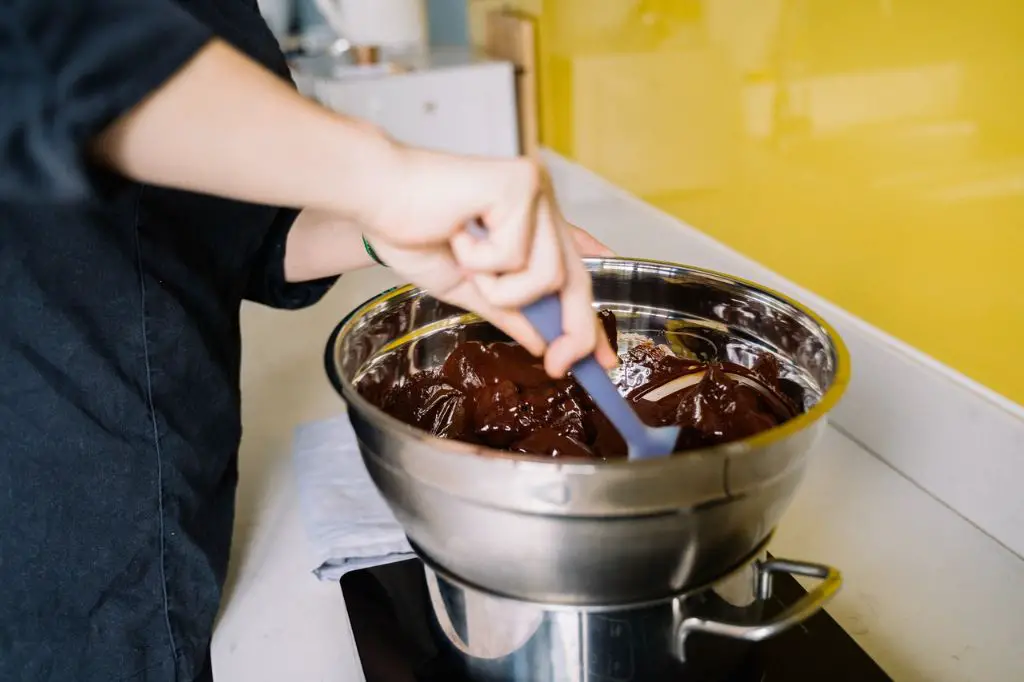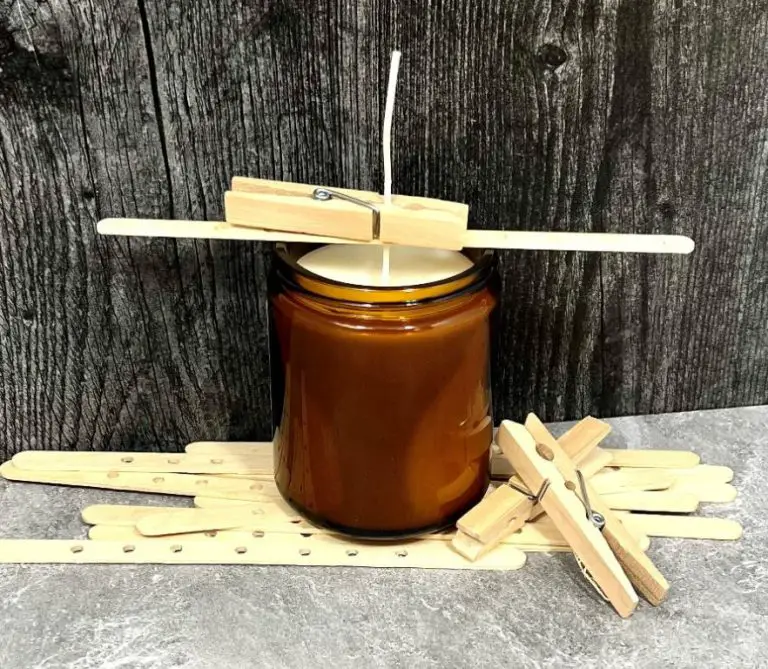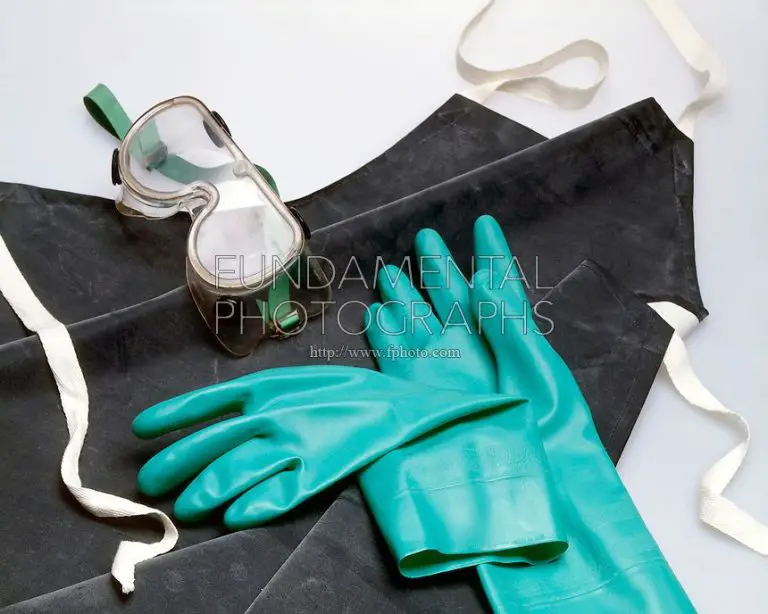How Much Water Should You Put In The Bottom Of A Double Boiler?
What is a Double Boiler?
A double boiler is a specialized type of cookware used for gently heating and cooking delicate foods. It consists of two pots or pans that fit together, with one sitting partly inside the other.
The bottom pot holds water and is placed over heat. The top pot sits above, supported by the rim of the bottom pot, and contains the food you want to cook. As the water in the bottom pot heats, it creates steam that gently surrounds and cooks the food in the top pot, preventing scorching or burning.
According to Merriam-Webster, a double boiler is “a cooking utensil consisting of two saucepans fitting together so that the contents of the upper can be cooked or heated by the boiling water in the lower.”
Some key purposes and uses for a double boiler include melting chocolate, making custards, cooking egg-based sauces, preparing delicate desserts, and more. The gentle heat helps prevent burning and allows for even heating.
Recommended Water Levels
Experts generally recommend using 1-2 inches of water in the bottom pot of a double boiler 1. This provides enough steam and heat to gently cook foods in the top pot without risking burning or scorching them. According to WebstaurantStore, you should “Fill the bottom pot with 1 or 2 inches of water.”
Similarly, WikiHow suggests filling the bottom pot “part-way with water. You will need about two inches (5.08 centimeters) of water.” They note that double boilers work by using steam, not direct contact with hot water, so there’s no need to submerge the top pot fully 2.
The recommended 1-2 inch water level allows steam to circulate and uniformly heat the top pot. It’s enough to generate consistent steam without water boiling over or running out. This balance of water optimizes the double boiler’s gentle cooking mechanism.
Factors That Impact Water Needs
There are several key factors that impact how much water you need to put in the bottom pot of a double boiler:
Stove Type: The type of stove you use affects water needs. On a gas stove, you may need less water since the flames provide direct, intense heat. On an electric or induction stove, you’ll likely need more water since the heat is less direct. Always check water levels periodically when using a new stove.
Pot Sizes: The size of the pots also matters. If you have a large bottom pot but small top pot, you may need less water to generate sufficient steam. Matching pot sizes means you’ll likely need more water for adequate steam production [1].
Altitude: At higher altitudes, water boils at lower temperatures due to lower air pressure. This means you may need more water to produce enough steam for cooking [2]. Check water levels frequently when using a double boiler at high altitude.
Too Little Water Risks
Using too little water in the bottom pot of a double boiler comes with several risks. The most notable risk is burning or scorching the food in the top pot. Without enough water in the bottom pot, the steam can run out before the cooking time is complete. This allows the direct heat from the burner to transfer to the top pot, raising its temperature beyond the boiling point of water and potentially burning the food.

According to one Reddit user, burning is a common problem with double boilers that touch the water: “I’ve been corrected recently that double boilers should not touch the boiling water underneath, but instead only heated by the rising steam” (source). Keeping the top pot suspended above the water prevents this direct transfer of heat.
In addition to burning food, having too little water can also damage the pots themselves. Allowing the water to boil off completely exposes the bottom metal pot to high heat that can discolor, warp, or crack it over time. Prevent this by monitoring water levels and adding more as needed.
Too Much Water Problems
Having too much water in the bottom pot of a double boiler can lead to some issues. The most dangerous problem is that water may get into the top pan and contaminate or dilute whatever you are trying to cook or heat. This can ruin recipes and lead to unsafe food conditions (source).
Additionally, having an excessive amount of water in the bottom pot leads to poor heat transfer to the top pan. The water acts as a barrier and absorbs too much of the heat rather than transferring it efficiently. This can lead to very slow heating or uneven cooking results (source).
Checking Water Levels
It’s important to periodically check the water level in the bottom pot of a double boiler to ensure it doesn’t boil dry. The easiest way to check is to look through the vent holes in the lid of the top pot. You should see the water simmering below. If no water is visible, remove the top pot and check the water level directly in the bottom pot. There should be 1-2 inches of water. If the water level is low, add more water to the bottom pot until you have the proper depth. Be careful when removing the lid of the top pot as steam can escape quickly. Always use oven mitts for protection.
You can also check the water by carefully lifting the top pan out of the bottom pot, but this runs the risk of burns from escaping steam. Looking through the vent holes is the safest method. Just be sure not to let the water completely evaporate. Keep a kettle of hot water nearby to easily replenish the bottom pot as needed.
Adding More Water
When using a double boiler, you may need to add more water to the bottom pot during the cooking process. It’s important to do this safely to avoid burns or scalding from hot steam or splashing water.
The safest way to add water is to turn off or remove the double boiler from heat first. Carefully lift the top pot out and set it on a heat-safe surface. Then add water slowly to the bottom pot, pouring it away from you to avoid splashes. Only add enough water to return to the starting level, usually 1-2 inches.
If you need to add water while the double boiler is still on the stove, use caution. Wear oven mitts and slowly pour or ladle water into the bottom pot, again pouring away from yourself. Keep your face clear of rising steam. An inch or two of water at a time is sufficient – avoid overflow.
Let the water adjust to the pot’s temperature before returning the top pot. This helps prevent cracking from sudden temperature changes. Always check that your food is not sticking or burning in the top pot when adding water to the bottom.
For safety, keep extra water nearby to refill as needed. But avoid putting in too much, as that can cause boiling over or water seeping into the top pot.
As a rule of thumb, only add enough water to keep the bottom of the top pot submerged in steam. This maintains ideal gentle heating.
When in doubt, turn off the heat and give the water time to cool slightly before adding more. With care, you can safely replenish water in your double boiler during cooking.
Tips for Success
One of the most important tips for successfully using a double boiler is to use a trivet. A trivet is a stand that elevates the top pot containing your ingredients above the bottom pot with the simmering water. This allows the steam to gently and evenly surround the top pot for indirect heating. According to Bon Appétit, it’s best to use a trivet that leaves about an inch of space between the two pots [1]. This gap prevents the top pot from getting too hot.
Another key tip is to allow room for the water in the bottom pot to evaporate over time. WebstaurantStore recommends filling the bottom pot with 2-3 inches of water initially [2]. As the water evaporates, you may need to periodically add more to maintain the level. Leaving room for evaporation prevents the bottom of the top pot from scorching if the water fully evaporates. Checking the water level occasionally and adding more as needed is important for success.
Common Uses
A double boiler is commonly used for delicate cooking tasks that require gentle, even heat. Two of the most popular uses are melting chocolate and making custards and sauces. The steam provides a stable, low temperature that helps prevent scorching or scalding these foods.
Chocolate is very sensitive to direct heat. If chocolate is heated too quickly or too high, it can scorch, seize up, or lose its temper. Using a double boiler allows the chocolate to melt gradually at a temperature below the boiling point of water. This gives you smoothly melted chocolate that is ready for dipping, molding, or using in recipes.
Custards and sauces like Hollandaise and Béarnaise rely on gentle heating to reach the right consistency without curdling or separating. The double boiler allows you to cook them through evenly without hot spots that could ruin the emulsion. This makes it easy to transform eggs and cream into silky custards and velvety sauces.
Alternatives
If you don’t have an actual double boiler, you can improvise one using items you likely have on hand in your kitchen. Here are some easy alternatives to create a double boiler effect:
Use a saucepan as the bottom pot filled with water, and place a heat-proof bowl on top as the top vessel. Ensure the bottom of the bowl does not touch the water. Stir the ingredients gently in the top bowl. This allows gentle, even heating without scorching (Source).
You can also improvise a double boiler by using two pots or pans of different sizes. Fill the larger pot with water and place the smaller pot inside, making sure the bottom pot does not touch the water. Put your ingredients in the smaller top pot. The water in the larger pot provides gentle heat without burning the ingredients (Source).
For a quick double boiler, place a heat-proof bowl over a pot of simmering water, forming a well-fitted double boiler. Monitor the water level and temperature. This allows slow heating without scorching sensitive ingredients.
With some simple kitchen items, you can improvise an effective double boiler for recipes calling for gentle uniform heating.





